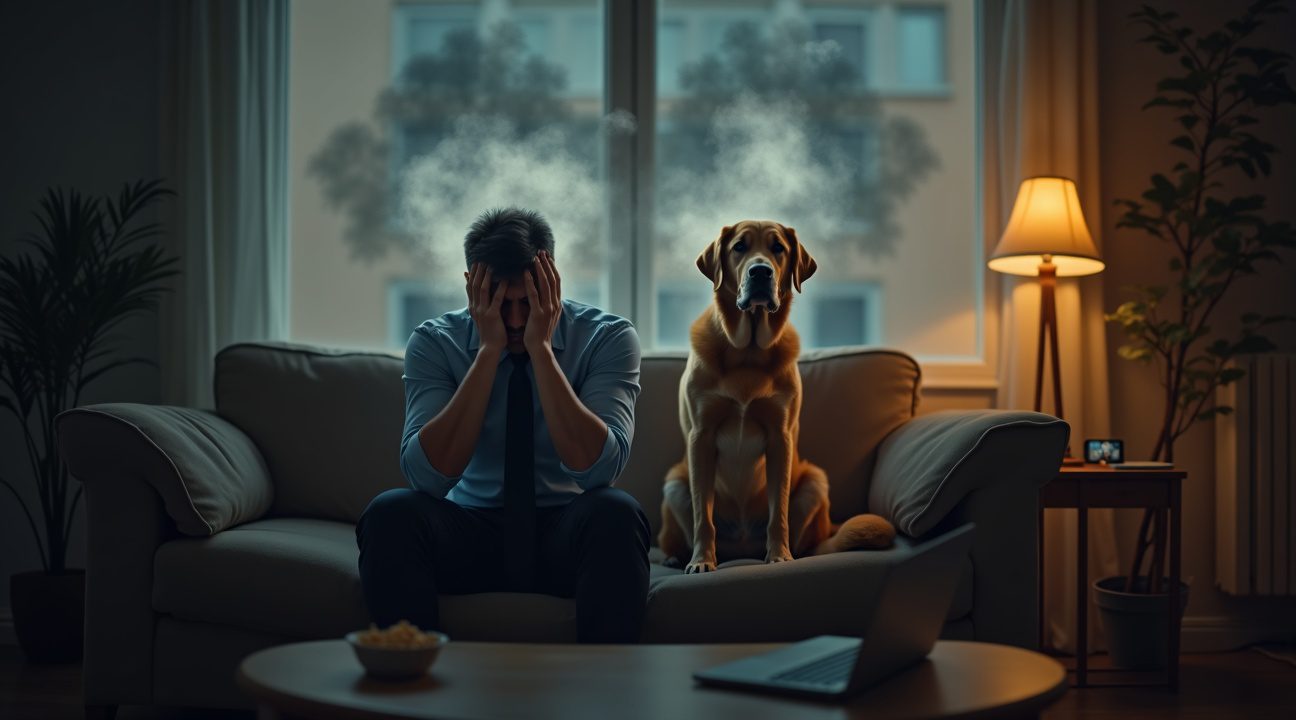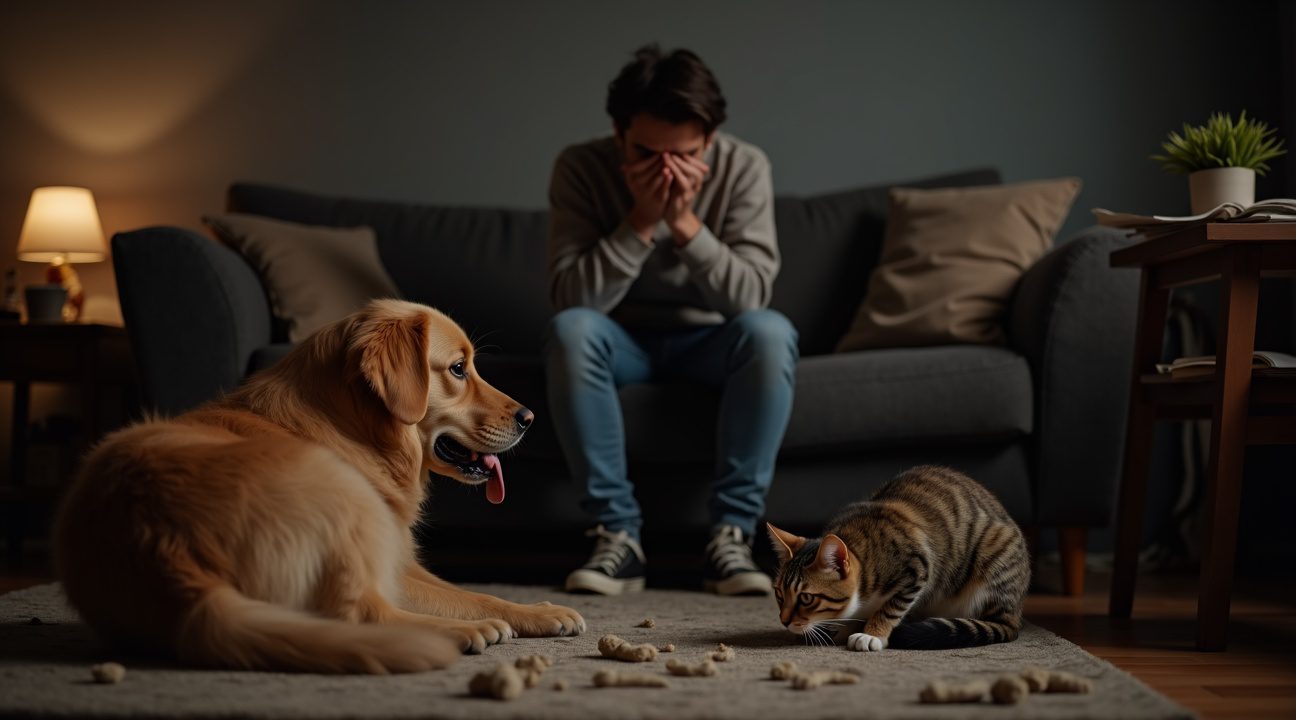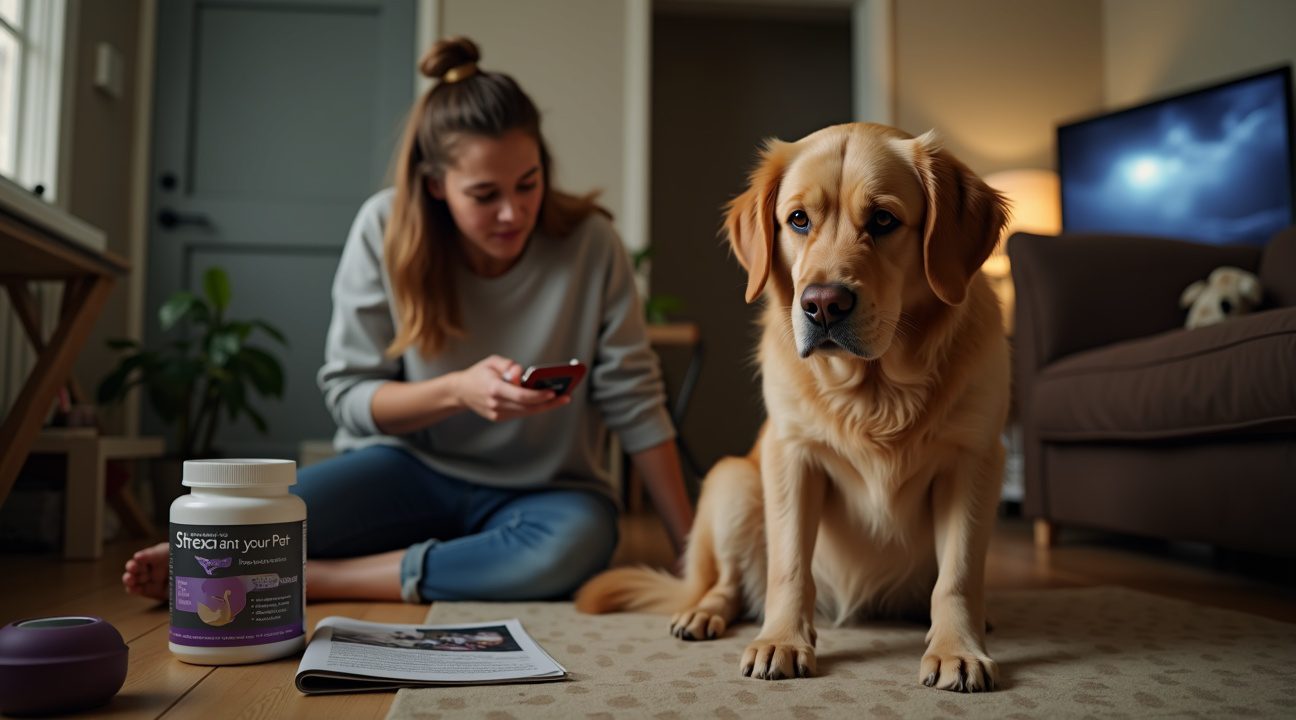Recent research published in Nature highlights a compelling link between workplace stress and canine anxiety, revealing that pets often absorb the emotional states of their owners through a process known as emotional contagion.
Key Takeaways
- Work stress directly transfers to pets through emotional contagion, with dogs exhibiting measurable anxiety when their owners experience high levels of workplace pressure.
- Mental rumination about job problems at home creates the strongest stress response in pets, emphasizing the importance of compartmentalizing work-related concerns from home life.
- Physical warning signs include excessive panting, destructive behaviors, changes in eating patterns, and withdrawal from family interaction in dogs. Cats may respond with excessive grooming, hiding, or increased vocalization.
- Chronic stress weakens pet immune systems, leading to higher susceptibility to infections and other health issues that may require veterinary intervention.
- Breaking the stress cycle requires consistent daily routines, environmental enrichment, and managing personal stress levels through self-care practices, which have mutual benefits for both pets and their owners.
For further insights on emotional contagion and pet health, you can explore the original study published in Nature.
Your Job Stress Is Making Your Dog Anxious Too
I’ve always suspected that pets pick up on human emotions, and groundbreaking research from Nature confirms this intuition with hard data. The study reveals a measurable connection between workplace stress and canine anxiety, proving that your four-legged friend absorbs more of your emotional state than you might realize.
The Science Behind Stress Transfer
The research demonstrates a clear pathway from your workplace frustrations to your dog’s behavior. When researchers measured behavioral stress on a scale from 1 to 5, they found a significant association between owner job stress and canine anxiety levels. The statistical relationship shows a notable effect, with dogs displaying heightened stress behaviors when their owners experience workplace pressure.
What makes this finding particularly compelling is the role of work-related rumination. The study found that owners who mentally replay job problems at home create the strongest stress response in their pets. This constant mental churning about workplace issues becomes the primary vehicle for transmitting anxiety to dogs. Your pet doesn’t understand spreadsheets or deadline pressures, but they absolutely sense when you’re mentally stuck in work mode during family time.
Real-World Impact on Pet Wellness
The numbers paint a concerning picture of pet mental health in modern households. Pet owners in the study rated their dogs’ stress levels at an average of 28.9 out of 100, while behavioral observations typically fell into the ‘rarely’ category at 2.06 out of 5. However, these seemingly moderate scores mask a more serious reality—a quarter of the dogs studied had received clinical diagnoses for anxiety or stress disorders.
This diagnostic rate aligns with broader veterinary data across the United States, suggesting that stress-related conditions in pets have reached epidemic proportions. Consider these observable stress indicators in your own pet:
- Excessive panting or drooling without physical exertion
- Destructive behaviors like chewing furniture or scratching doors
- Changes in eating patterns or appetite loss
- Increased vocalization or whimpering
- Withdrawal from family activities or hiding behaviors
- Repetitive actions like excessive grooming or pacing
The emotional contagion effect works both ways in the human-animal bond. Just as achieving milestones in professional life can boost household morale, persistent job stress creates a feedback loop where anxious pets contribute to owner stress levels. Dogs and cats rely heavily on routine and emotional stability from their human companions. When that foundation becomes shaky due to work pressures, pets develop their own coping mechanisms that often manifest as problematic behaviors.
Interestingly, the research highlights that it’s not necessarily the stress itself causing problems, but rather how owners process and carry that stress into their home environment. People who can compartmentalize work stress and remain mentally present during pet interactions show significantly lower rates of stress transfer to their animals.
This finding offers hope for busy professionals who can’t eliminate workplace pressure but can modify how they handle it at home. Simple practices like taking ten minutes to decompress before entering the house or establishing work-free zones during pet care activities can break the cycle of stress transmission. Your dog picks up on subtle cues like body language, vocal tone, and energy levels, making your emotional state during shared time more important than the absolute amount of stress you experience at work.
Understanding this connection empowers pet owners to take proactive steps in protecting their animals’ mental health while managing their own professional demands. The research validates what many pet owners instinctively know—that our emotional states profoundly impact our animal companions’ wellbeing.

The Physical Warning Signs Your Pet Is Absorbing Your Bad Vibes
I’ve observed that pets act like emotional sponges, soaking up their owner’s stress through subtle physiological changes that often go unnoticed. Heart rate variability serves as a critical indicator of stress levels in both humans and animals, with lower HRV signaling higher stress states. When your pet experiences chronic stress from absorbing negative energy, their body responds with measurable physical symptoms that demand immediate attention.
Recognizing Species-Specific Stress Responses
Dogs display their stress absorption through several distinct behavioral changes that I’ve documented repeatedly:
- Excessive panting becomes noticeable even when temperatures remain comfortable.
- Trembling or shaking occurs without obvious triggers.
- Increased shedding often accompanies these symptoms, leaving behind more fur than usual throughout the house.
- Changes in appetite manifest as either complete food rejection or anxious overeating.
- Behavioral shifts such as clinginess or total withdrawal from family interactions.
Cats express stress differently but equally dramatically through their own set of warning signs:
- Excessive grooming creates visible bald patches, especially around the stomach, legs, or flanks.
- Hiding becomes their primary coping mechanism, often under beds, in closets, or behind furniture for prolonged periods.
- Increased vocalization through persistent meowing, yowling, or crying signals deep distress.
- Aggression may surface, targeting family members or other pets.
Both species commonly develop digestive issues when stress overwhelms their systems:
- Vomiting episodes that increase in frequency.
- Diarrhea becomes a regular occurrence, disrupting normal bathroom routines.
These gastrointestinal symptoms often puzzle owners who haven’t yet connected their pet’s physical distress to the household emotional climate.
Sleep patterns shift dramatically in stressed pets. Some animals experience insomnia, while others sleep excessively. Energy levels fluctuate unpredictably, creating alternating periods of hyperactivity and unusual lethargy. Changes in appetite also serve as reliable early warning signs, whether pets refuse their favorite treats or suddenly become food-aggressive.
Destructive behavior is another major red flag:
- Dogs may chew furniture, shoes, or objects they previously ignored.
- Cats may scratch inappropriate surfaces or knock objects off counters.
Vocalization patterns change as well, with distressed pets expressing their discomfort through whining, barking, howling, or unfamiliar meows.
Aggression is one of the most concerning stress responses, especially when directed at family members who have never before witnessed such behavior from their pet. This often stems from the animal’s inability to process overwhelming emotional input from their stressed human companions. Some pets may become reactive in otherwise normal situations, snapping at children, other animals, or their primary caregivers.
Physical symptoms go beyond behavior:
- Posture and movement may shift, with pets carrying tension, walking differently, or holding their ears, tails, or heads in unusual positions.
- Eye changes such as dilated pupils or a “thousand-yard stare” signal inner turmoil.
Temperature regulation can also become compromised. Stressed pets might pant excessively in cool environments or shiver when conditions don’t warrant it. Breathing patterns may become rapid and shallow, or unusually deep and labored, even at rest.
Grooming habits change significantly with stress:
- Some animals stop grooming entirely, leading to matted fur and dirty coats.
- Others groom compulsively until they create bald spots or skin damage.
These extreme grooming behaviors often reflect the emotional climate of the household, making them vital indicators of stress absorption.
Awareness of these warning signs enables pet owners to take timely action. By recognizing early signs of emotional overload, owners can implement environmental and emotional changes to support their pet’s well-being. Intervening early not only protects the health of your pet but can also foster a more balanced and emotionally stable home for everyone.
For a more visual understanding of how pets react to household stress, consider watching informative videos or consulting with veterinarians or animal behaviorists. Educational content like this one helps reinforce the importance of mental and emotional well-being in animal care:
https://www.youtube.com/watch?v=V1R2LBTn_uY

When Your Pet’s Stress Becomes a Serious Health Problem
Chronic stress doesn’t just make pets uncomfortable—it transforms their bodies into breeding grounds for illness. I’ve observed how persistent anxiety weakens immune systems, leaving furry companions vulnerable to infections that healthy pets would easily fight off. This compromised immunity creates a domino effect where minor health issues escalate into serious chronic conditions.
Physical Health Consequences of Persistent Stress
Prolonged stress manifests in various physical ailments that pet owners often don’t connect to anxiety. Skin disorders become particularly common, with stressed pets developing hot spots, excessive scratching, and persistent dermatitis that refuses to heal. Gastrointestinal upset presents another frequent complication, where anxious animals experience chronic diarrhea, vomiting, or loss of appetite that conventional treatments can’t resolve.
The immune system bears the heaviest burden during extended stress periods. White blood cell function diminishes significantly, making pets susceptible to bacterial infections, viral outbreaks, and parasitic infestations. Even routine vaccinations may prove less effective when administered to chronically stressed animals, as their compromised immune response can’t mount adequate protection.
Clinical Diagnosis and Treatment Options
Research indicates that approximately 25% of dogs studied show diagnosed anxiety disorders when experiencing recurrent stress. This statistic represents only documented cases—many pets suffer silently without formal diagnosis. Veterinarians increasingly recognize stress-related symptoms and offer comprehensive treatment approaches that address both behavioral and physiological aspects.
Treatment protocols often begin with environmental modifications and progress to medical interventions when necessary. Pheromone diffusers provide a non-invasive starting point, releasing calming synthetic hormones that mimic natural comfort signals. These devices work particularly well for situational anxiety like thunderstorms or gaming sessions that might create household tension.
Dietary supplements offer another valuable tool in stress management:
- Omega-3 fatty acids
- L-theanine
- Specialized calming formulas
These can help regulate neurotransmitter function without pharmaceutical side effects. However, severe cases may require anti-anxiety medications prescribed by veterinarians who carefully monitor dosage and response.
Professional intervention becomes essential when stress triggers persist despite initial management attempts. Certified animal behaviorists bring specialized expertise to identify specific anxiety sources and develop customized modification plans. These professionals work closely with pet owners to implement gradual desensitization techniques and counter-conditioning protocols that address root causes rather than just symptoms.
The collaboration between veterinary medicine and behavioral science has proven particularly effective for complex cases. Some pets benefit from combination therapy that includes both pharmaceutical support and behavioral modification. This dual approach helps stabilize immediate symptoms while building long-term coping mechanisms that improve overall quality of life.
Pet owners shouldn’t hesitate to seek professional help when stress impacts daily functioning. Warning signs include:
- Persistent hiding
- Changes in aggression
- Elimination problems
- Sudden or worsening destructive behaviors
Early intervention prevents minor stress responses from developing into serious anxiety disorders that require intensive treatment.
Recovery timelines vary significantly based on individual pets, stress duration, and underlying health factors. Some animals respond quickly to environmental changes and basic interventions, while others need months of consistent treatment to show improvement. Patience remains crucial throughout the process, as rushing recovery often leads to setbacks that prolong suffering.
The investment in professional stress management pays dividends through improved health outcomes and strengthened human-animal bonds. Pets receiving appropriate anxiety treatment typically show enhanced immune function, better digestive health, and increased social engagement. These improvements create positive feedback loops where reduced stress leads to better health, which further decreases anxiety levels and promotes overall wellbeing.

How Cats and Dogs Show Stress Differently Than Humans
I’ve witnessed countless pets mirror their owners’ emotional states, yet the way stress manifests in cats and dogs differs dramatically from human responses. While humans can verbalize their anxiety or seek help, our furry companions rely on body language and behavioral changes to communicate their distress.
Feline Stress Signals
Cats express stress through distinct behavioral patterns that often puzzle their owners.
- Increased hiding becomes a primary defense mechanism, with stressed felines retreating to closets, under beds, or behind furniture for extended periods.
- Excessive grooming presents another clear indicator—cats may lick themselves raw, creating bald patches or skin irritations.
- Aggression can surface unexpectedly, transforming previously gentle cats into defensive animals that hiss, scratch, or bite.
- Withdrawal from social interaction, including avoiding favorite activities or refusing to eat, signals deep-seated anxiety.
These behaviors often escalate when owners experience prolonged stress periods.
Canine Anxiety Manifestations
Dogs demonstrate stress through more vocal and physically active responses compared to their feline counterparts.
- Excessive barking becomes a common outlet, particularly when owners aren’t home or during tense household moments.
- Pacing and panting occur even in comfortable temperatures, indicating internal turmoil rather than physical discomfort.
- Destructive behaviors emerge as stressed dogs channel anxiety into chewing furniture, shoes, or digging holes in yards.
- Changes in appetite—some dogs experience appetite loss while others become increasingly clingy, following their owners from room to room.
Both species can display opposite reactions, showing lethargy instead of hyperactivity or complete avoidance rather than attention-seeking behaviors. Sleep disruption affects many stressed pets, causing them to wake frequently or struggle falling asleep. Physical symptoms mirror human stress responses—hair loss appears in patches, weight fluctuations occur rapidly, and digestive issues become common.
The fundamental difference lies in pets’ inability to rationalize their stress or address root causes independently. Unlike humans who can identify stressors and develop coping strategies, animals remain trapped in reactive cycles. Their stress levels become heavily dependent on owner behavior and environmental consistency. When I observe pet-owner relationships, stressed humans invariably create stressed pets, often without realizing their emotional state transfers directly to their companions.
Environmental changes amplify these stress responses. Moving homes, schedule disruptions, or introducing new family members can trigger intense anxiety in pets already sensitive to their owners’ emotional states. Unlike humans who might find entertainment distractions to cope with stress, pets lack these outlets and depend entirely on their environment for comfort and security.
Simple Ways to Break the Stress Cycle With Your Pet
Breaking the stress cycle between you and your pet requires a multi-faceted approach that addresses both environmental factors and your own emotional state. I’ve found that implementing consistent strategies can dramatically improve both your wellbeing and your pet’s quality of life.
Establishing Stability Through Daily Routines
Consistent daily schedules form the foundation of stress management for pets. I recommend establishing fixed times for feeding, exercise, and play sessions, as these predictable patterns help reduce anxiety in both dogs and cats. Your pet thrives on knowing what to expect, and this stability becomes especially important during stressful periods. Regular meal times not only support digestive health but also provide emotional anchoring points throughout the day. Exercise routines should be maintained even when life gets hectic, as physical activity helps both you and your pet release tension naturally.
Creating designated safe spaces throughout your home gives your pet options for retreat when stress levels rise. Cats particularly benefit from elevated perches, cozy hiding spots, and quiet corners where they can observe without feeling exposed. Dogs often prefer a comfortable bed in a low-traffic area where they can rest undisturbed. I suggest placing these safe zones away from household commotion, ensuring your pet always has access to a calm environment.
Managing Your Own Stress for Mutual Benefit
Managing your own stress levels directly impacts your pet’s emotional state, making self-care an essential component of pet wellness. Regular exercise, mindfulness practices, and maintaining social connections help regulate your stress hormones, which your pet can sense and mirror. When I practice deep breathing exercises or meditation, I notice my pets often settle down nearby, benefiting from the calm energy. Seeking professional support during challenging times isn’t just beneficial for you – it’s an investment in your pet’s mental health as well.
Enriching Your Pet’s Environment
Environmental enrichment plays a crucial role in reducing stress-related behaviors. Interactive toys, puzzle feeders, and rotating playthings keep your pet mentally stimulated and less likely to develop anxiety-driven habits. For cats, scratching posts and climbing structures provide natural outlets for stress relief. Dogs benefit from chew toys and sniffing activities that engage their natural instincts.
I’ve observed that pets with adequate mental stimulation show fewer stress symptoms and adapt better to household changes.
Monitoring for Early Warning Signs
Vigilant monitoring allows you to catch stress indicators before they escalate into serious health issues. Watch for changes in:
- Appetite
- Sleep patterns
- Grooming habits
- Social behavior
These often signal developing anxiety. Excessive panting, hiding, aggression, or destructive behavior warrant immediate attention. Documentation of these changes helps veterinarians assess whether stress has become chronic and requires professional intervention.
Early Intervention and Professional Guidance
Early intervention prevents minor stress from developing into persistent anxiety disorders. I recommend establishing a relationship with a veterinarian who understands behavioral issues, as they can provide both medical assessment and behavior modification strategies. Some pets benefit from:
- Calming supplements
- Pheromone diffusers
- Environmental modifications tailored to specific stressors
Strengthening the Bond Through Positive Interaction
Physical touch and positive interactions strengthen the bond between you and your pet while reducing cortisol levels for both parties. Gentle petting, brushing, or simply sitting quietly together can lower stress hormones and promote relaxation. However, respect your pet’s boundaries during anxious periods, as forced interaction can increase rather than decrease stress levels.
Adjusting Household Habits
Consider how household dynamics might be affecting your pet’s stress levels. Loud music, frequent visitors, or chaotic schedules can overwhelm sensitive animals. I’ve found that making small adjustments like lowering television volume or providing advance warning before house guests arrive can significantly improve your pet’s comfort level. Creating calm transitions between high-energy activities and rest periods helps your pet regulate their emotional state more effectively.
Consistency Over Perfection
Remember that breaking the stress cycle takes time and patience. Consistency in your approach matters more than perfection, and small daily improvements compound into significant long-term benefits for both you and your pet.
For more tips on pet wellness and stress management, check out this ASPCA guide on stress relief for pets.
https://www.youtube.com/watch?v=WXhXpc8sWuI

Creating a Stress-Free Environment for Both You and Your Pet
Building a calm environment for your pet starts with addressing the stress in your own life. I’ve learned that pets pick up on human emotions through a phenomenon called emotional contagion, meaning your anxiety can literally become their anxiety. When I’m stressed, my pet often mirrors that energy, becoming restless or withdrawn.
Essential Strategies for Environmental Balance
Creating an enriched environment helps redirect your pet’s anxious energy into positive outlets. I recommend incorporating these elements into your daily routine:
- Interactive toys that challenge your pet mentally and physically
- Puzzle feeders that turn mealtime into engaging problem-solving sessions
- Regular play sessions scheduled at consistent times throughout the day
- Designated quiet zones where your pet can retreat when feeling overwhelmed
Consistency becomes your pet’s security blanket. I maintain regular feeding times, walk schedules, and bedtime routines because predictability reduces uncertainty-based stress. Your pet learns to anticipate positive experiences rather than worry about what comes next.
Quiet zones serve as emotional safe havens. I set up comfortable spaces away from household traffic where my pet can decompress. These areas include soft bedding, familiar scents, and minimal stimulation. Think of them as your pet’s personal meditation corner.
Owner stress management directly impacts pet wellbeing. I practice meditation for ten minutes each morning, which helps me start the day with calm energy. Regular exercise releases tension that might otherwise transfer to my pet. Setting clear work-life boundaries prevents me from bringing office stress home where it can affect the entire household atmosphere.
Recognition of this emotional connection changes how I approach daily interactions. When I feel overwhelmed, I take time to regulate my emotions before engaging with my pet. Deep breathing exercises, brief walks outside, or listening to calming music helps reset my emotional state.
The ripple effect works both ways. Creating a peaceful environment for my pet actually reduces my own stress levels. Watching a content, relaxed pet reinforces positive feelings and creates a feedback loop of calm energy throughout the home.
Physical environment modifications support emotional wellbeing. I keep noise levels moderate, maintain comfortable temperatures, and ensure adequate lighting. Strong scents from cleaning products or air fresheners can overwhelm sensitive pet senses, so I choose mild, pet-safe alternatives.
Your emotional regulation becomes a gift to your pet. By managing your stress levels through consistent self-care practices, you create an atmosphere where both you and your pet can thrive. This approach recognizes that pet wellness and human wellness are interconnected aspects of a harmonious household.
Sources:
Nature, “Dog owners’ job stress crosses over to their pet dogs via emotional contagion”
PMC, “Assessing the Relationship Between Emotional States of Dogs and Their Owners”
Inaroad Animal Hospital, “The Surprising Connection Between Human Stress and Pet Behavior”


